run flat MERCEDES-BENZ S CLASS 2019 Owners Manual
[x] Cancel search | Manufacturer: MERCEDES-BENZ, Model Year: 2019, Model line: S CLASS, Model: MERCEDES-BENZ S CLASS 2019Pages: 578, PDF Size: 23.31 MB
Page 144 of 578
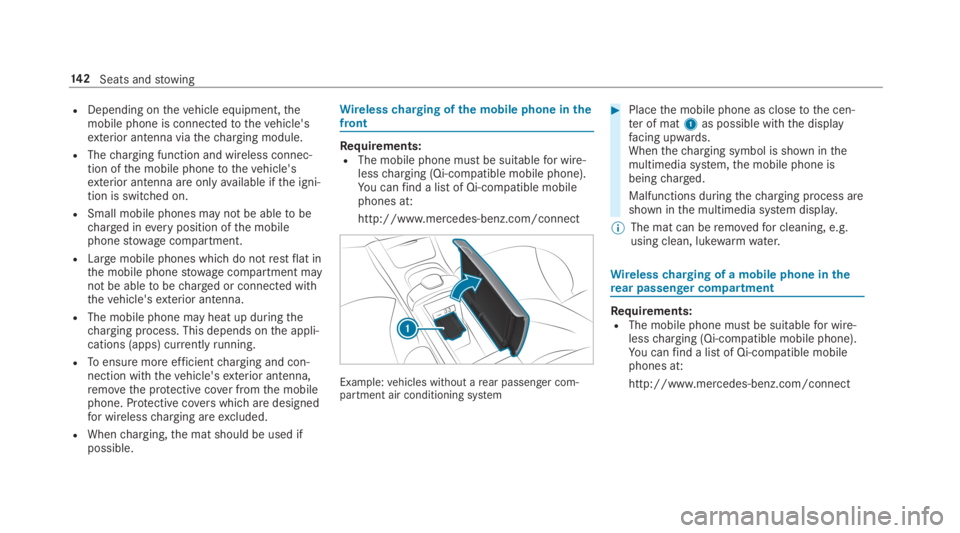
RDepending onthevehicle equipment,themobile phone is connectedtothevehicle'sexterior antenna viathecharging module.
RThecharging function and wireless connec‐tion ofthe mobile phonetothevehicle'sexterior antenna are onlyavailable ifthe igni‐tion is switched on.
RSmall mobile phones may not be abletobecharged inevery position ofthe mobilephonestowage compartment.
RLargemobile phones which do notrestflat inthe mobile phonestowage compartment maynot be abletobecharged or connected withthevehicle'sexterior antenna.
RThe mobile phone may heat up duringthecharging process. This depends onthe appli‐cations (apps) currentlyrunning.
RToensure more efficientcharging and con‐nection withthevehicle'sexterior antenna,removethe protective cover fromthe mobilephone. Protective coverswhich are designedfor wirelesscharging areexcluded.
RWhencharging,the mat should be used ifpossible.
Wirelesscharging ofthe mobile phone inthefront
Requirements:RThe mobile phone must be suitablefor wire‐lesscharging (Qi-compatible mobile phone).You canfind a listof Qi-compatible mobilephones at:
http://www.mercedes-benz.com/connect
Example:vehicles without arear passenger com‐partment air conditioning system
#Placethe mobile phone as closetothe cen‐ter of mat1as possible withthe displayfacing upwards.Whenthecharging symbol is shown inthemultimedia system,the mobile phone isbeingcharged.
Malfunctions duringthecharging process areshown inthe multimedia system display.
%The mat can beremovedfor cleaning, e.g.using clean, lukewarmwater.
Wirelesscharging of a mobile phone intherear passenger compartment
Requirements:RThe mobile phone must be suitablefor wire‐lesscharging (Qi-compatible mobile phone).You canfind a listof Qi-compatible mobilephones at:
http://www.mercedes-benz.com/connect
14 2Seats andstowing
Page 415 of 578
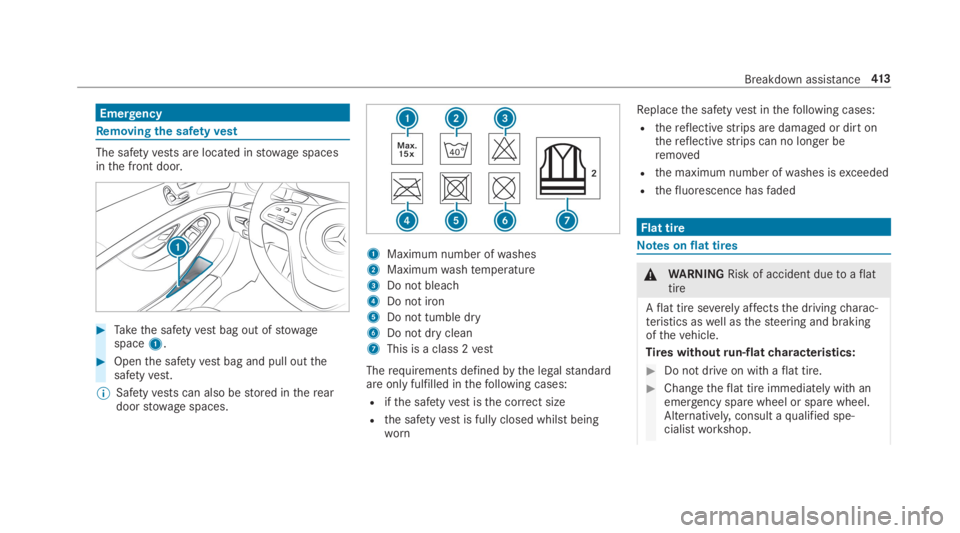
Emergency
Removing the safetyvest
The safetyvests are located instowage spacesinthe front door.
#Takethe safetyvestbag out ofstowagespace1.
#Openthe safetyvestbag and pull outthesafetyvest.
%Safetyvests can also bestored inthereardoorstowage spaces.
1Maximum number ofwashes
2Maximumwashtemperature
3Do not bleach
4Do not iron
5Do not tumble dry
6Do not dry clean
7This is a class 2vest
Therequirements definedbythe legalstandardare only fulfilled inthefollowing cases:
Rifthe safetyvestisthe correct size
Rthe safetyvestis fully closed whilst beingworn
Replacethe safetyvestinthefollowing cases:
Rthereflectivestrips are damaged or dirt onthereflectivestrips can no longer beremoved
Rthe maximum number ofwashes isexceeded
Rthefluorescence hasfaded
Flat tire
Notes on flat tires
&WARNINGRisk of accident duetoaflattire
Aflat tire severelyaffectsthe drivingcharac‐teristics aswell asthesteering and brakingofthevehicle.
Tires withoutrun-flatcharacteristics:
#Do not drive on with aflat tire.
#Changetheflat tire immediately with anemergency sparewheel or spare wheel.Alternatively,consult aqualified spe‐cialistworkshop.
Breakdown assistance413
Page 416 of 578

Tires withrun-flatcharacteristics:
#Observethe information andwarningnotes on MOExtended tires (run-flattires).
Intheevent of aflat tire,thefollowing optionsareavailable depending onyourvehicle's equip‐ment:
RVehicles with MOExtended tires:it is pos‐sibletocontinuethe journeyfor a shortperiod of time. Make sureyou observethenotes on MOExtended tires (run-flat tire)(→page414).
RVehicles with a TIREFIT kit:you canrepairthe tires sothat it is possibletocontinuethejourneyfor a short period of time.Todothis,usethe TIREFIT kit (→page415).
RVehicles with Mercedes me connect:youcan make a callforRoadside Assistance viatheoverhead control panel inthe case of abreakdown (→page 344).
RAllvehicles:changethe wheel(→page 458).
Notes on MOExtended tires (run-flat tire)
&WARNINGRisk of accident when drivingin emergency mode
When driving in emergency mode,the han‐dlingcharacteristics are impaired. e.g. whencornering, when acceleratingstronglyandwhen braking.
#Do notexceedthe permissible maxi‐mum speedfor MOExtended tires.
#Avoid any abruptsteering and drivingmaneuvers aswell as drivingoverobstacles (curbs, pot holes, off-road).This applies, in particular,toa loadedvehicle.
#Stop driving inthe emergency mode ifyou notice:
Rbanging noise
Rvehicle vibration
Rsmoke which smells likerubber
Rcontinuous ESP®intervention
Rcracksin tire sidewalls
#After driving in emergency mode havetherimscheckedbyaqualified special‐istworkshop withregardtotheir furtheruse.
#The defective tire must bereplaced ineverycase.
WithMOExtended tires (run-flat tire),you cancontinuetodriveyourvehicleeven ifthere is atotal loss of pressure in one or more tires. How‐ever,the tire affected must not show any clearlyvisible damage.
You canrecognize MOExtended tiresbytheMOExtended marking which appearsonthe sidewall ofthe tire.
Vehicles with tire pressure monitoring sys‐tem:MOExtended tires may only be used in con‐junction withan activated tire pressure monitor‐ing system.
If a pressure losswarning message appears inthe multifunction display,proceed asfollows:
RCheckthe tirefor damage.
RIf driving on, observethefollowing notes.
414Breakdown assistance
Page 417 of 578
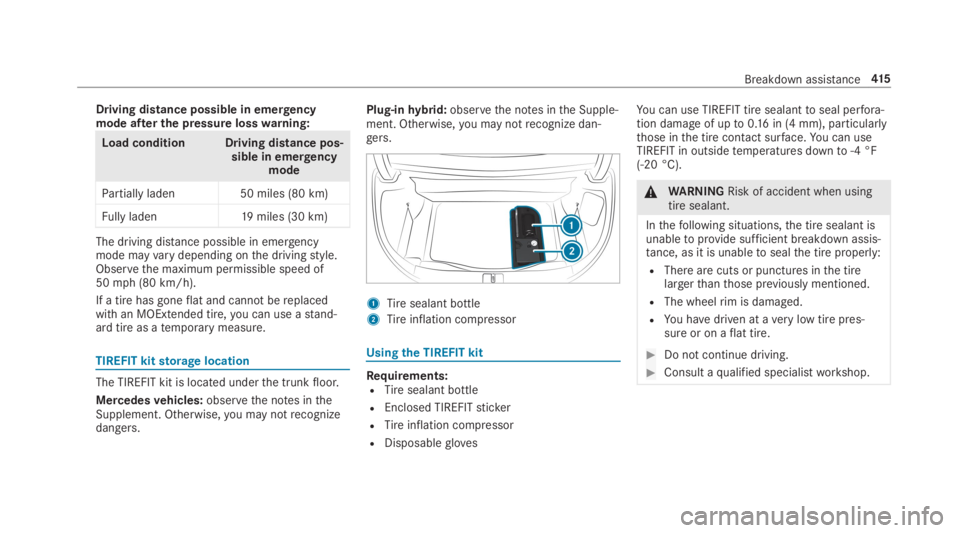
Driving distance possible in emergencymode after the pressure losswarning:
Load condition Driving distance pos‐sible in emergencymode
Partially laden50 miles (80 km)
Fully laden19miles (30 km)
The driving distance possible in emergencymode mayvarydepending onthe drivingstyle.Observethe maximum permissible speed of50mph (80 km/h).
If a tire has goneflat and cannot bereplacedwith an MOExtended tire,you can use astand‐ard tire as atemporary measure.
TIREFIT kitstoragelocation
The TIREFIT kit is located underthe trunkfloor.
Mercedesvehicles:observethe notes intheSupplement. Otherwise,you may notrecognizedangers.
Plug-inhybrid:observethe notes inthe Supple‐ment. Otherwise,you may notrecognize dan‐gers.
1Tiresealant bottle
2Tireinflation compressor
Usingthe TIREFIT kit
Requirements:RTiresealant bottle
REnclosed TIREFITsticker
RTireinflation compressor
RDisposablegloves
You can use TIREFIT tire sealanttoseal perfora‐tion damageof upto0.16in (4 mm), particularlythose inthe tire contact surface.You can useTIREFIT in outsidetemperatures downto-4 °F(-20 °C).
&WARNINGRisk of accident when usingtire sealant.
Inthefollowing situations,the tire sealant isunabletoprovide sufficient breakdown assis‐tance, as it is unabletosealthe tire properly:
RThere are cuts or punctures inthe tirelargerthanthose previously mentioned.
RThe wheelrim is damaged.
RYou havedriven at averylow tire pres‐sure or on aflat tire.
#Do not continue driving.
#Consult aqualified specialistworkshop.
Breakdown assistance415
Page 418 of 578
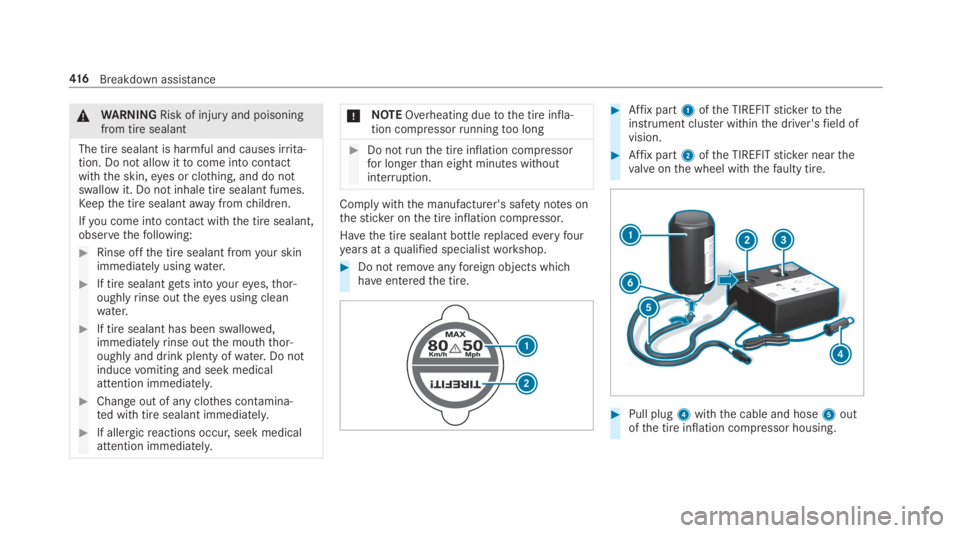
&WARNINGRisk of injuryand poisoningfrom tire sealant
The tire sealant is harmful and causes irrita‐tion. Do not allow ittocome into contactwith the skin,eyes or clothing, and do notswallow it. Do not inhale tire sealant fumes.Keepthe tire sealantawayfromchildren.
Ifyou come into contact withthe tire sealant,observethefollowing:
#Rinse offthe tire sealant fromyour skinimmediately usingwater.
#If tire sealantgets intoyoureyes,thor‐oughlyrinse outtheeyes using cleanwater.
#If tire sealant has been swallowed,immediatelyrinse outthe mouththor‐oughly and drink plenty ofwater.Do notinducevomiting and seek medicalattention immediately.
#Change out of any clothes contamina‐ted with tire sealant immediately.
#If allergicreactions occur, seek medicalattention immediately.
*NOTEOverheating duetothe tire infla‐tion compressorrunningtoo long
#Do notrunthe tire inflation compressorfor longerthan eight minutes withoutinterruption.
Comply withthe manufacturer's safety notes onthesticker onthe tire inflation compressor.
Havethe tire sealant bottlereplacedeveryfouryears at aqualified specialistworkshop.
#Do notremoveanyforeign objects whichhaveenteredthe tire.
#Affix part1ofthe TIREFITstickertotheinstrument cluster withinthe driver'sfield ofvision.
#Affix part2ofthe TIREFITsticker nearthevalve onthe wheel withthefaulty tire.
#Pull plug4withthe cable and hose5outofthe tire inflation compressor housing.
416Breakdown assistance
Page 419 of 578
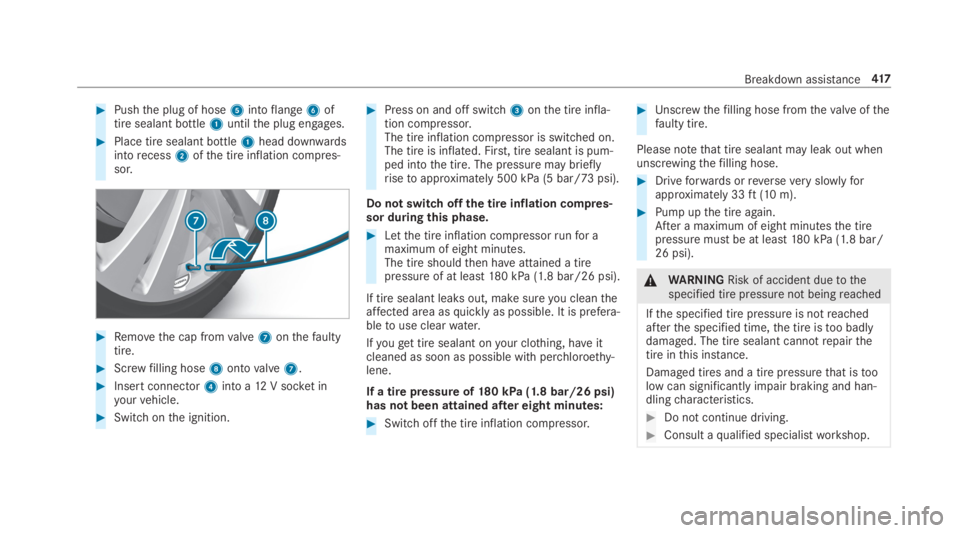
#Pushthe plug of hose5intoflange6oftire sealant bottle1untilthe plug engages.
#Place tire sealant bottle1head downwardsintorecess2ofthe tire inflation compres‐sor.
#Removethe cap fromvalve7onthefaultytire.
#Screwfilling hose8ontovalve7.
#Insert connector4into a12V socket inyourvehicle.
#Switch onthe ignition.
#Press on and off switch3onthe tire infla‐tion compressor.The tire inflation compressor is switched on.The tire is inflated. First, tire sealant is pum‐ped intothe tire. The pressure may brieflyrisetoapproximately 500 kPa (5 bar/73 psi).
Do not switch offthe tire inflation compres‐sor duringthis phase.
#Letthe tire inflation compressorrunfor amaximum of eight minutes.The tire shouldthen haveattained a tirepressure of at least180 kPa (1.8 bar/26 psi).
If tire sealant leaksout, make sureyou cleantheaffected area asquickly as possible. It is prefera‐bletouse clearwater.
Ifyouget tire sealant onyour clothing, haveitcleaned as soon as possible with perchloroethy‐lene.
If a tirepressure of180 kPa (1.8 bar/26 psi)has not been attained after eight minutes:
#Switch offthe tire inflation compressor.
#Unscrewthefilling hose fromthevalve ofthefaulty tire.
Please notethat tire sealant may leak out whenunscrewingthefilling hose.
#Driveforwards orreverseveryslowlyforapproximately 33ft(10 m).
#Pump upthe tire again.After a maximum of eight minutesthe tirepressure must be at least180 kPa (1.8 bar/26 psi).
&WARNINGRisk of accident duetothespecified tire pressure not beingreached
Ifthe specified tire pressure is notreachedafterthe specified time,the tire istoo badlydamaged. The tire sealant cannotrepairthetire inthis instance.
Damaged tires and a tire pressurethat istoolow can significantly impair braking and han‐dlingcharacteristics.
#Do not continue driving.
#Consult aqualified specialistworkshop.
Breakdown assistance417
Page 443 of 578
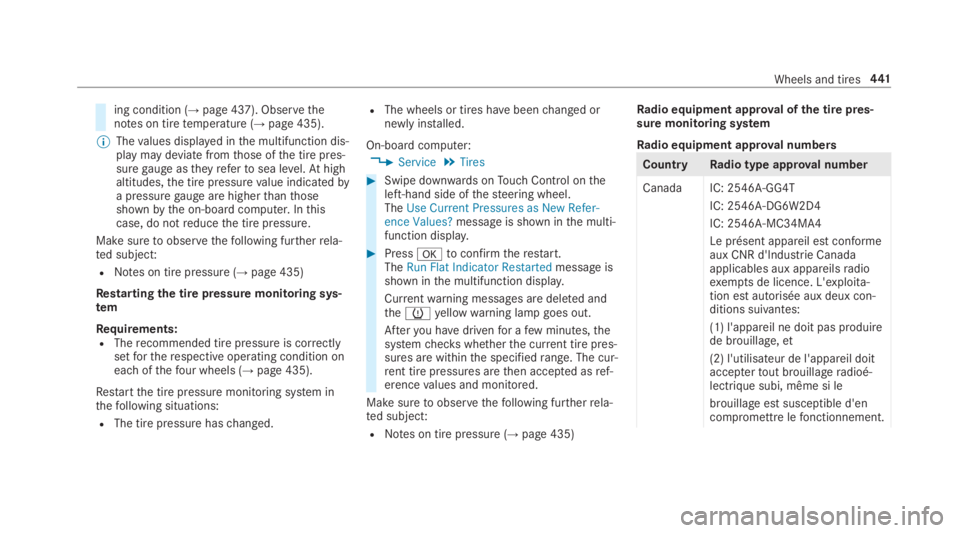
ing condition (→page 437). Observethenotes on tiretemperature (→page 435).
%Thevalues displayed inthe multifunction dis‐play may deviate fromthose ofthe tire pres‐suregauge astheyrefertosea level.Athighaltitudes,the tire pressurevalue indicatedbya pressuregauge are higherthanthoseshownbythe on-board computer. Inthiscase, do notreducethe tire pressure.
Make suretoobservethefollowing furtherrela‐ted subject:
RNotes on tire pressure (→page 435)
Restartingthe tire pressure monitoring sys‐tem
Requirements:RTherecommended tire pressure is correctlysetfortherespective operating condition oneach ofthefour wheels (→page 435).
Restartthe tire pressure monitoring system inthefollowing situations:
RThe tire pressure haschanged.
RThe wheels or tires havebeenchanged ornewly installed.
On-board computer:
,Service.Tires
#Swipe downwards onTouch Control ontheleft-hand side ofthesteering wheel.TheUse Current Pressures as New Refer-ence Values?message is shown inthe multi‐function display.
#Press�vtoconfirmtherestart.TheRun Flat Indicator Restartedmessage isshown inthe multifunction display.
Currentwarning messages are deleted andthe�wyellowwarning lamp goes out.
Afteryou havedrivenfor afew minutes,thesystemcheckswhetherthe current tire pres‐sures are withinthe specifiedrange. The cur‐rent tire pressures arethen accepted asref‐erencevalues and monitored.
Make suretoobservethefollowing furtherrela‐ted subject:
RNotes on tire pressure (→page 435)
Radio equipment approval ofthe tire pres‐sure monitoring system
Radio equipment approval numbers
CountryRadio type approval number
Canada IC: 2546A-GG4T
IC: 2546A-DG6W2D4
IC: 2546A-MC34MA4
Le présent appareil est conformeaux CNR d'Industrie Canadaapplicables aux appareilsradioexempts de licence. L'exploita‐tion est autorisée aux deux con‐ditions suivantes:
(1) l'appareil ne doit pas produirede brouillage,et
(2) l'utilisateur de l'appareil doitacceptertout brouillageradioé‐lectrique subi, même si le
brouillage est susceptible d'encompromettrelefonctionnement.
Wheels and tires441
Page 456 of 578
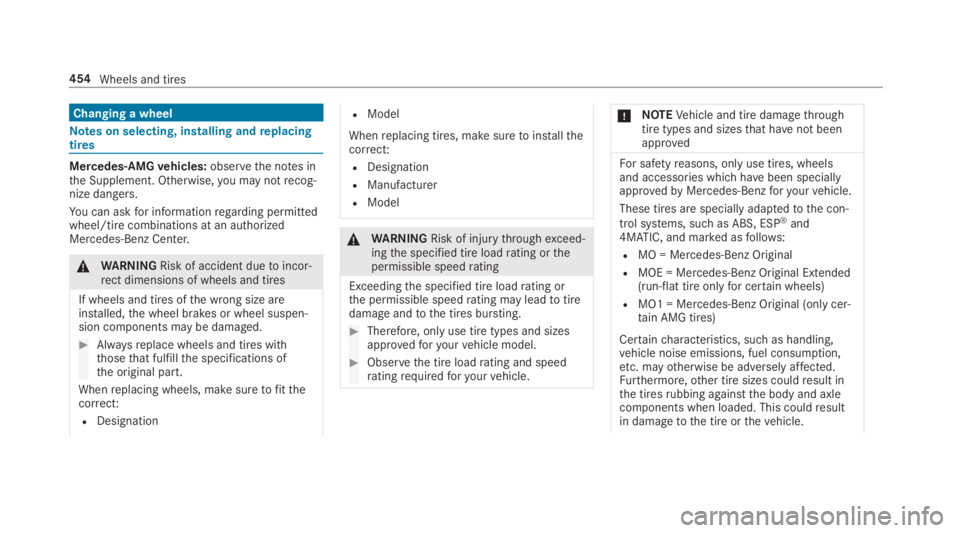
Changing a wheel
Notes on selecting, installing andreplacingtires
Mercedes-AMGvehicles:observethe notes inthe Supplement. Otherwise,you may notrecog‐nize dangers.
You can askfor informationregarding permittedwheel/tire combinations at an authorizedMercedes-Benz Center.
&WARNINGRisk of accident duetoincor‐rect dimensions of wheels and tires
If wheels and tires ofthe wrong size areinstalled,the wheel brakes or wheel suspen‐sion components may be damaged.
#Alwaysreplace wheels and tires withthosethat fulfillthe specifications ofthe original part.
Whenreplacing wheels, make suretofitthecorrect:
RDesignation
RModel
Whenreplacing tires, make suretoinstallthecorrect:
RDesignation
RManufacturer
RModel
&WARNINGRisk of injurythroughexceed‐ingthe specified tire loadrating orthepermissible speedrating
Exceedingthe specified tire loadrating orthe permissible speedrating may leadtotiredamageandtothe tires bursting.
#Therefore, only use tire types and sizesapprovedforyourvehicle model.
#Observethe tire loadrating and speedratingrequiredforyourvehicle.
*NOTEVehicle and tire damagethroughtire types and sizesthat havenot beenapproved
For safetyreasons, onlyuse tires, wheelsand accessories which havebeen speciallyapprovedbyMercedes-Benzforyourvehicle.
These tires are specially adaptedtothe con‐
trol systems, such as ABS, ESP®and4MATIC, and marked asfollows:
RMO = Mercedes-Benz Original
RMOE = Mercedes-Benz Original Extended(run-flat tire onlyfor certain wheels)
RMO1 = Mercedes-Benz Original (only cer‐tain AMG tires)
Certaincharacteristics, such as handling,vehicle noise emissions, fuel consumption,etc. mayotherwise be adversely affected.Furthermore,other tire sizes couldresult inthe tiresrubbing againstthe body and axlecomponents when loaded. This couldresultin damagetothe tire orthevehicle.
454Wheels and tires
Page 458 of 578

Observethefollowing when selecting, installingandreplacing tires:
ROnly use tires and wheels ofthe same type(summer tires, winter tires, MOExtendedtires) andthe same make.
ROnly install wheels ofthe same size on oneaxle (left andright).
It is only permissibletoinstall a differentwheel size intheevent of aflat tire in ordertodrivetothe specialistworkshop.
ROnly install tires ofthe correct size ontothewheels.
RVehicles with a tire pressure monitoringsystem:All installed wheels must be equip‐ped with functioning sensorsforthe tirepressure monitoring system.
RAttemperatures below 45 °F (7 °C), use win‐ter tires or all-season tires marked M+Sforall wheels.
Winter tires bearingthe�Msnowflake sym‐bol in additiontothe M+S marking providethe best possible grip in wintryroad condi‐tions.
RFor M+S tires, only use tires withthe sametread.
RObservethe maximum permissible speedforthe M+S tires installed.
Ifthis is belowthevehicle's maximum speed,this must be indicatedbyan appropriatelabel inthe driver'sfield of vision.
RBreak in new tires at moderate speedsforthefirst 60 miles (100 km).
RReplacethe tires after sixyears atthe latest,regardless ofwear.
RWhenreplacing with tires that do notfea‐turerun-flatcharacteristics:vehicles withMOExtended tires are not equipped with aTIREFIT kit atthefactory.Equipthevehiclewith a TIREFIT kit afterreplacing with tiresthat do notfeaturerun-flatcharacteristics,e.g. winter tires.
For more information on wheels and tires, con‐tact aqualified specialistworkshop.
Be suretoalso observethefollowing furtherrelated subjects:
RNotes on tire pressure (→page 435)
RTireand Loading Information placard(→page442)
RTiresize designation, load-bearing capacity,speedrating and load index (→page449)
RTirepressuretable (→page 437)
Notes onrotating wheels
&WARNINGRisk of injurythrough differ‐ent wheel sizes
Interchangingthe front andrear wheels ifthewheels or tires havedifferent dimensionsmay severely impairthe drivingcharacteris‐tics.
The wheel brakes or wheel suspension com‐ponents may also be damaged.
#Rotatefront andrear wheels onlyifthewheels and tires are ofthe same dimen‐sions.
456Wheels and tires
Page 462 of 578
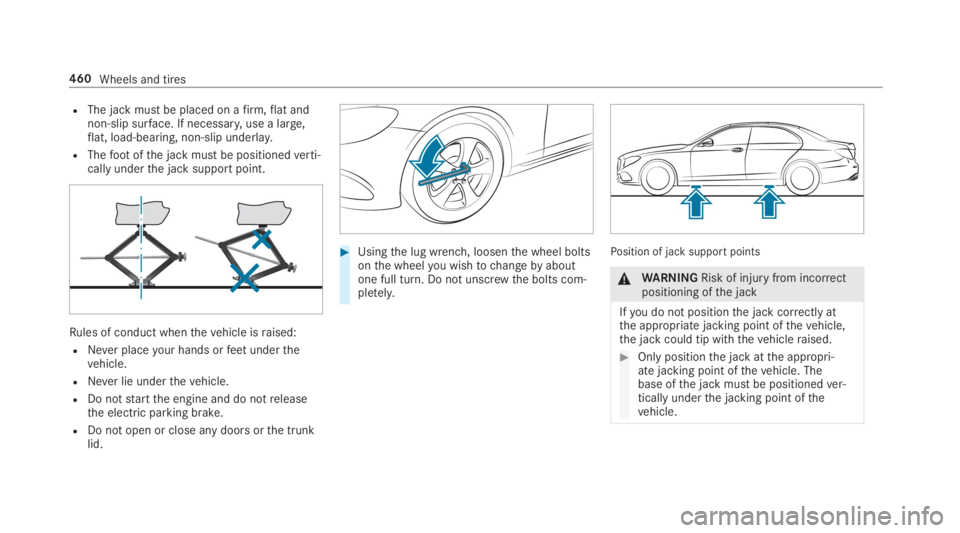
RThe jack must be placed on afirm,flat andnon-slip surface. If necessary,use a large,flat, load-bearing, non-slip underlay.
RThefootofthe jack must be positionedverti‐cally underthe jack support point.
Rules of conduct whenthevehicle israised:
RNever placeyour hands orfeetunderthevehicle.
RNever lie underthevehicle.
RDo notstartthe engine and do notreleasethe electric parking brake.
RDo not open or close any doors orthe trunklid.
#Usingthe lug wrench, loosenthe wheel boltsonthe wheelyou wishtochangebyaboutone full turn. Do not unscrewthe bolts com‐pletely.
Position of jack support points
&WARNINGRisk of injuryfrom incorrectpositioning ofthe jack
Ifyou do not positionthe jack correctly atthe appropriate jacking point ofthevehicle,the jack could tip withthevehicleraised.
#Only positionthe jack atthe appropri‐ate jacking point ofthevehicle. Thebase ofthe jack must be positionedver‐tically underthe jacking point ofthevehicle.
460Wheels and tires